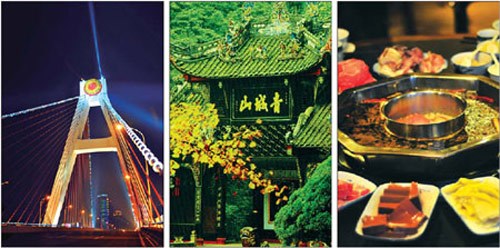
Left to right: Night view of the Tianfu Bridge in Chengdu, the provincial capital. Gateway to the Qingcheng Mountains, birthplace of Taoism. Renowned Sichuan hotpot is one of the city's signature dishes.

The 5-square-kilometer Jinsha site in the city's western suburbs has been hailed as one of the major archeological discoveries in China.
Home of the giant panda, ancient wonders and renowned cuisine, Li Fusheng reports.
The UN World Tourism Organization unveiled an agency to observe tourism development on Oct 12 in Chengdu, the capital city of Southwest China's Sichuan province, as part of its Global Observatory on Sustainable Tourism program.
The Chengdu observatory, the organization's fifth in China, will collect data for scientific studies on sustainable tourism development by monitoring local tourism and environmental protection as well as social, cultural and economic developments.
The UNWTO also plans to hold a summit on world sustainable tourism development in Chengdu early next year.
The moves are expected to help enhance the city's reputation as major tourism city in China, said local tourism officials.
Chengdu has abundant tourism attractions including the nation's giant panda breeding research center.
Ten kilometers from downtown Chengdu, the center is home to about 70 of the highly endangered species, which number fewer than 2,000 worldwide. About 75 percent are found in Sichuan.
The facility has been created to resemble the natural habitat of the giant panda, with large open spaces for them to roam free and providing the best venue to see the iconic animals up close.
The center also breeds other endangered species such as the red panda and the black-necked crane.
Places of interest
While the panda center tends to attract kids and animal lovers, what impresses many other visitors to Chengdu is the ancient Dujiangyan irrigation system.
Built in 256 BC by local official Li Bing to tame frequent flooding of the Minjiang River, it is probably the oldest functioning water-control project in the world.
The Dujiangyan system, which has stood for nearly 2,300 years, silently diverts water to irrigate nearly 70,000 hectares of farmland that produce almost a third of the province's grain. It survived the disastrous Wenchuan Earthquake almost unscathed in 2008.
Together with Chengdu's Qingcheng Mountains, the Dujiangyan irrigation system was included on the list of UNESCO world heritage sites in 2000.
Offering unique attractions on its 36 peaks, the Qingcheng Mountains have long been recognized as the birthplace of Taoism, China's ancient indigenous religion.
Chengdu is also home to 3,000-year-old remains of the Jinsha settlement, which is widely believed to have been the capital of the ancient Shu state.
Located in the city's western suburbs, the 5-square-kilometer Jinsha site has been hailed as one of the major archeological discoveries in China in the 21st century, according to local historians.
About 50 kilometers from the famed Sanxingdui remains in Sichuan province, Jinsha rose to prominence around 1000 BC and shares similar origins with Sanxingdui, as can be seen from similar burial objects, historians said, although Jinsha had no city wall.
More than 800 tombs have been excavated in the Jinsha ruins dating from the middle of the Western Zhou Dynasty (c. 11th century - 771 BC) to the early Spring and Autumn Period (770 - 476 BC). Artifacts made from ivory, jade, bronze, gold and stone have been found at the site.

Copyright ©1999-2011 Chinanews.com. All rights reserved.
Reproduction in whole or in part without permission is prohibited.